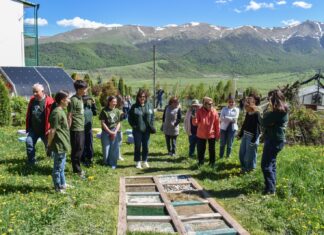By Lucy Joulfayan-Yeghyayan
WATERTOWN — The Knights of Vartan Ararat Otyag Number 1 of Boston and the Daughters of Vartan (DOV) Arpie Otyag Number 9 of Boston held their monthly meeting on November 12. A few highlights marked the pre-meeting traditional dinner which was held at Charles Mosesian Cultural and Youth Center – Keljik Hall of St. James Armenian Apostolic Church.
Dr. Knarik Arkun, Dirouhi of Arpie Otyag Number 9, welcomed the audience and presented the program after the official opening by the Ararat Otyag Number 1 Sbarabed Argishti Chaparian, and a prayer by Fr. Stephan Baljian.

Arpie Otyag members prepared and served the Thanksgiving dinner from scratch. However, one addition to the traditional Thanksgiving menu was meant to introduce a complementary Armenian element to the traditional American meal. “Ghapama,” or stuffed pumpkin, is one of our oldest traditional, national dishes and a pride of the Armenian cuisine. Historically, it has been celebrated as a centerpiece during the Armenian New Year, weddings and other holiday occasions. Our folk culture has included it in its popular art forms. We have songs and dances about ghapama, and it is present in drawings and literature.
For centuries, every part of our ethnic cuisine in the ancestral homeland and beyond has maintained ghapama as one of its delicacies. The fame of this dish traveled with the diaspora communities to their new villages, towns and cities. Many believed that ghapama is the trademark of their village or town because they had discovered new spices and vegetable types in their new hometowns which they added to the original ingredients of the dish, thus creating the several versions/recipes that we enjoy in our times. Traditionally, regardless of the recipe/filling, whether in the homeland or the diaspora, our ancestors baked ghapama in the Armenian “tonir” or oven. For its recipe, click here.
Including ghapama on the combined Thanksgiving and the DOV anniversary dinner menu is symbolic. It was meant to help revive interest in our ethnic, cultural cuisine and traditions. Understanding the challenges in preserving the Armenian cultural heritage and eventually, ensuring its continuation in the diaspora, the DOV Arpie Otyag Number 9 will likely include more activities that would help revive and preserve several of the forgotten, and endangered elements in the Armenian cultural heritage, in the future. Preserving our identity in our constantly developing lifestyles is an ever-growing challenge. Our ethnic or ethnographic elements need more attention in order to survive the threats of extinction.








